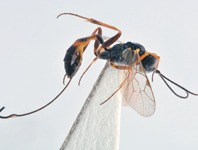Abstract
Species descriptions are provided for five new species of Hemerodromia (H. aliaextriata sp. nov., H. deprimatura sp. nov., H. oretenebraea sp. nov., H. pairoti sp. nov. H. samoha sp. nov.). The new species have an apparently obligate association with calcareous streams, rivers and tufa formations in limestone karst landforms in Thailand. Hemerodromia menghaiensis Yang & Yang is here reported for the first time in Thailand.
References
Câmara, J.T., Plant, A.R. & Rafael, J.A. (2014) Neotropical Hemerodromia Meigen (Diptera: Empididae), a world of discovery I: new generic record and new species from Brazilian Amazon Basin. Zootaxa, 3879 (2), 209–231.
https://doi.org/10.11646/zootaxa.3893.2.3
Cumming, J.M., Sinclair, B.J. & Wood, D.M. (1995) Homology and phylogenetic implications of male genitalia in Diptera—Eremoneura. Entomologica Scandinavica, 26, 121–151.
https://doi.org/10.1163/187631295x00143
Fallén, C.F. (1815) Empidiae Sveciae. Berlingianis, Lundae, 16 pp.
I.C.Z.N. (2014) Opinion 2347 (Case 3589). Hemerodromia Meigen, 1822 and Hemerodromiinae Schiner, 1862 (Insecta, Diptera, Empididae): genus-group and family-group names conserved. Bulletin of Zoological Nomenclature, 71 (4), 265–266.
https://doi.org/10.21805/bzn.v71i4.a4
Ivković, M., Miliša, M. & Mihaljević, Z. (2010) The aquatic dance flies fauna (Diptera, Empididae: Hemerodromiinae and Clinocerinae) of the Plitvice Lakes National Park. Natura Croatica, 19, 133–139.
Kepčija R.M., Habdija, I., Primc-Habdija, B. & Miliša, M. (2006) Simuliid silk pads enhance tufa deposition. Archiv für Hydrobiologie, 166, 387–409.
https://doi.org/10.1127/0003-9136/2006/0166-0387
Martín-Algarra, A., Martín-Martín, M., Andreo, B., Julía, R. & González-Gómez, C. (2003) Sedimentary patterns in perched spring travertines near Granada (Spain) as indicators of the paleohydrological and paleoclimatological evolution of a karst massif. Sedimentary Geology, 161, 217–228.
https://doi.org/10.1016/S0037-0738(03)00115-5
Meigen, J.W. (1822) Systematische Beschreibung der bekannten europäischen zweiflügeligen Insekten. Dritter Theil. Schultz-Wundrmann, Hamm, 416 pp.
McAlpine, J.F. (1981) Morphology and terminology—Adults. In: McAlpine, J.F., Peterson, B.V., Shewell, G.E., Teskey, H.J., Vockeroth, J.R. & Wood, D.M. (Coords.), Manual of Nearctic Diptera. Vol. 1. Agriculture Canada Monograph, 27, pp. 9–63.
Pedley, M., Rogerson, M. & Middleton, R. (2009) Freshwater calcite precipitates from in vitro mesocosm flume experiments: a case for biomediation of tufas. Sedimentology, 56, 511–527.
https://doi.org/10.1111/j.1365-3091.2008.00983.x
Plant, A.R. (2007) The Hemerodromiinae (Diptera: Empididae) of New Zealand, II. Chelipoda Macquart. Zootaxa, 1537 (1), 1–88.
https://doi.org/10.11646/zootaxa.1537.1.1
Plant, A.R. (2011) Hemerodromiinae (Diptera: Empididae): a tentative phylogeny and biogeographical discussion. Systematic Entomology, 36, 83–103.
https://doi.org/10.1111/j.1365-3113.2010.00547.x
Plant, A.R. (2015) Diversity of Hemerodromia Meigen, 1822 (Diptera: Empididae) in Thailand, the tip of a tropical iceberg? Zootaxa, 4039 (1), 1–56.
https://doi.org/10.11646/zootaxa.4039.1.1
Plant, A.R. (2019) Biomediation of tufa formation by silk capture nets of larval Philopotamidae (Insecta: Trichoptera). Tropical Natural History, 19 (2), 113–116.
Plant, A.R., Bickel D.J., Chatelaine, P., Daugeron, C. & Srisuka, W. (2019) Composition and organization of highly speciose Empidoidea (Diptera) communities in tropical montane forests of northern Thailand. Zootaxa, 4590 (1), 1–39.
https://doi.org/10.11646/zootaxa.4590.1.1
Plant, A.R. & Sinclair, B.J. (2008) New species of Hemerodromia Meigen from Fiji (Diptera: Empididae). Fiji Arthropods XI, Bishop Museum Occasional Papers, 98, 31–52.
Przhiboro, A.A. & Shamshev, I.V. (2006) Dance flies from the shore zone of Lake Krivoe, Northern Karelia (Diptera: Empididae, Hybotidae). Zoosystematica Rossica, 15, 333–334.
Rondani, C. (1856) Dipterologiae Italicae prodromus. Vol. I. Genera Italica ordinis dipterorum ordinatim disposita et distincta et in familias et stirpes aggregata. A. Stocchi, Parmae (Parma), 226 + [2] pp.
https://doi.org/10.5962/bhl.title.8160
Sinclair, B.J. (2000) Morphology and terminology of Diptera male terminalia. In: Papp, L. & Darvas, B. (Eds.), Contributions to a Manual of Palaearctic Diptera. Vol. 1. General and Applied Dipterology. Science Herald, Budapest, pp. 53–74.
Sinclair, B.J. & Cumming, J.M. (2006) The morphology, higher-level phylogeny and classification of the Empidoidea (Diptera). Zootaxa, 1180 (1), 1–172.
https://doi.org/10.11646/zootaxa.1180.1.1
Stuckenberg, B.R. (1999) Antennal evolution in the Brachycera (Diptera), with a reassessment of terminology relating to the flagellum. Studia dipterologica, 6, 33–48.
Yang, D. & Yang, C. (2004) Diptera: Empididae: Hemerodromiinae, Hybotinae. Fauna Sinica, Insecta, 34, i–x + 1–335.
Yang, D., Zhang, K., Yao, G. & Zhang, J. (2007) World Catalog of Empididae (Insecta: Diptera). China Agricultural Press, Beijing, 599 pp.
Zhang, D.D., Zhang, Y., Zhu, A. & Cheng, X. (2001) Physical methods of river waterfall tufa (travertine) formation. Journal of Sedimentary Research, 71, 205–216.

